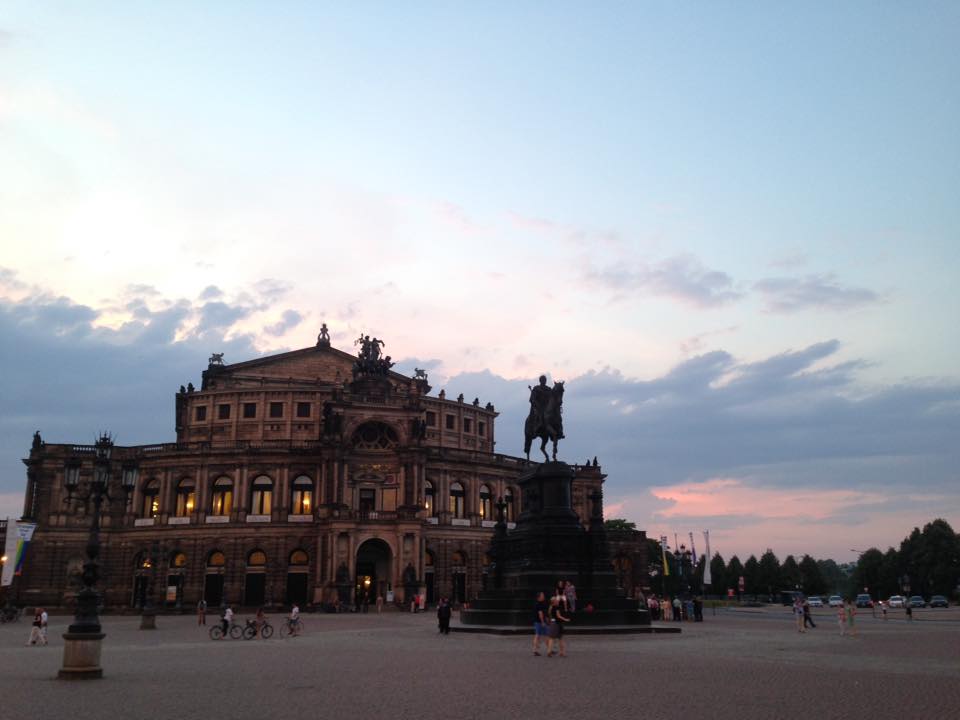This year marked the seventieth anniversary of the firebombing of Dresden, and the legacy of the Second World War remains omnipresent in Dresden.
| The view of Dresden and the Elbe River from the very top of the Frauenkirche. |
This beautiful city is located in the heart of Saxony, along the Elbe River. In fact, local residents fondly refer to Dresden as the “Florence on the Elbe.” The city is rich with history, culture, art, and music, and Dresden’s city center is home to a palace (Zwinger), opera house (Semperoper), and historic church (Frauenkirche).
Despite all of its beautiful Baroque and Rococo architecture, much of what tourists see today in the Altstadt, or “Old Town,” is relatively new. This area had to be completely rebuilt after its destruction during World War II.
 |
| A lovely summer’s day along the Elbe River. The distinct silhouette of the Altstadt from the other side of the Elbe is commonly referred to as the “Canaletto View,” after the famous painting by Bernardo Bellotto. |
On February 13, 1945, the British Royal Air Force and U.S. Army Air Force bombed Dresden. The controversial raid lasted for two days and caused a massive firestorm in the city center. The majority of civilian deaths were due to suffocation, as the fire withdrew oxygen from their air raid shelters and homes.
Although the exact number of casualties is unknown, it is estimated that anywhere from 18,000 to 25,000 people died during this attack.
 |
|
| The Fürstenzug, or Procession of Princes, is a large mural that shows the rulers of Saxony. Little damage was done to it during the 1945 bombing of Dresden; The German—British Rose Garden was dedicated in May 2011 to the citizens of Dresden who died during the 1945 firebombing. The Rose Garden symbolizes reconciliation between Great Britain and Germany. | |
The Nazis immediately used the bombing to create propaganda against the Allied forces because the attack on Dresden ostensibly had no strategic military value. And the destroyed city quickly became a lasting symbol of German victimhood during the Second World War.
| The reconstructed Frauenkirche located in the center of the Altstadt. Now it stands as a powerful symbol of German victimhood and wartime devastation. |
Located in the heart of the “Old Town,” the Lutheran church of our Lady, Frauenkirche, was one of the many historic landmarks destroyed during the bombing of Dresden.
 |
|
| The beautifully reconstructed interior of the Frauenkirche; A different perspective from the top of the Frauenkirche. | |
It remained in ruins until 1994 because neither the church nor the state government could afford to rebuild it immediately after the war. In fact, it was largely private efforts and individual donations that led to its reconstruction. It cost about 180 million euros in total to rebuild the church, and the process was finally completed in 2005.
 |
| Graffiti found near the Großer Garten that says, “This is not Disneyland. This is the dark East." |
Since then, the Frauenkirche has become variously a symbol of peace, a reminder of the horrors of war, and an annual rallying point for neo-Nazis commemorating the firebombing.
Unfortunately in recent years, Dresden has become known as a hotbed of right-wing conservatism and neo-Nazism. It is the birthplace of Pegida, a radical, xenophobic, anti-Islamic political party, which has quickly gained popularity among the older generation of Germans. They are angered because of the mass influx of refugees from war-torn parts of the globe seeking asylum in Germany. In fact, Dresden and surrounding local towns have established refugee camps that have experienced racist attacks on several occasions during the past few months.
Thankfully, all hope is not lost. The youth of Dresden frequently hold protests and demonstrations against Pegida. While walking through Neustadt, one sees many signs welcoming refugees and graffiti and street art condemning fascism, racism, sexism, nationalism, and Nazism.
| Typical example of anti-Nazi graffiti found in Neustadt. |
In particular, the political organization known as Dresden Nazifrei actively seeks to protect refugees from violence and discrimination. By drawing upon anti-Nazi rhetoric to promote their goals of toleration, Dresden Nazifrei reminds us that such dangerous, conservative ideologies are still active and continue to pose a threat to basic human rights.
Whether they are conscious of it or not, the people of Dresden daily confront their city’s complicated past as they walk through its beautiful streets.
 |
| Sunset by the famous opera house, known as the Semperoper. |
[All photos by Nikki Freeman, 2015]
